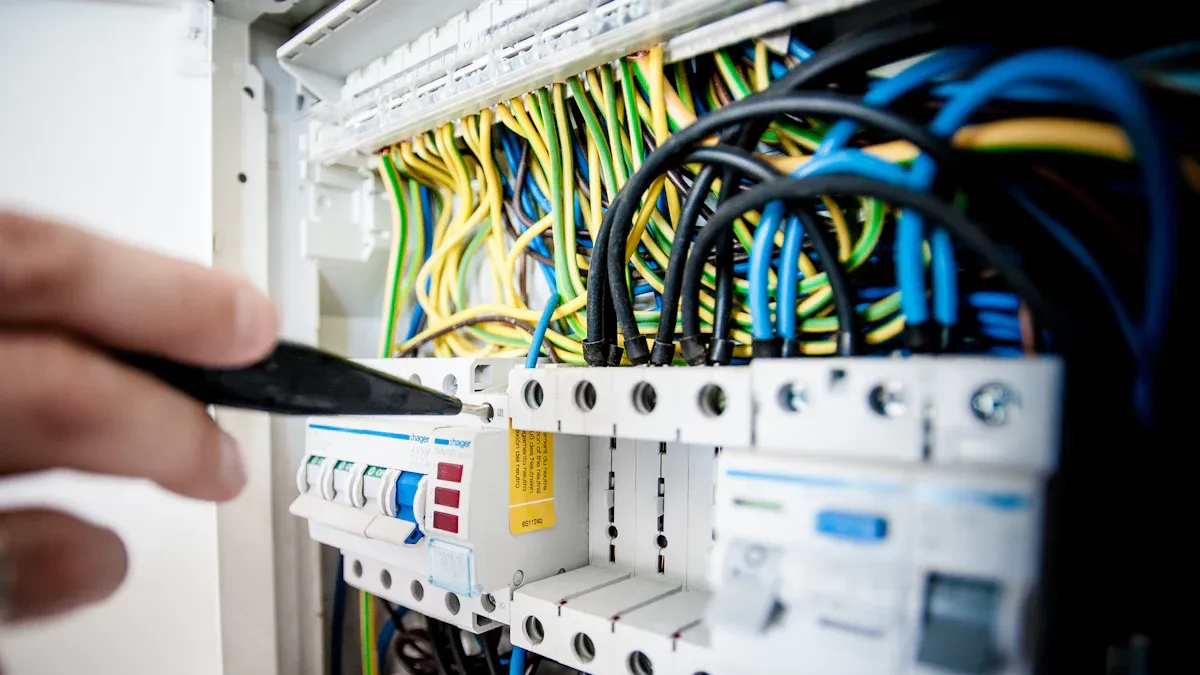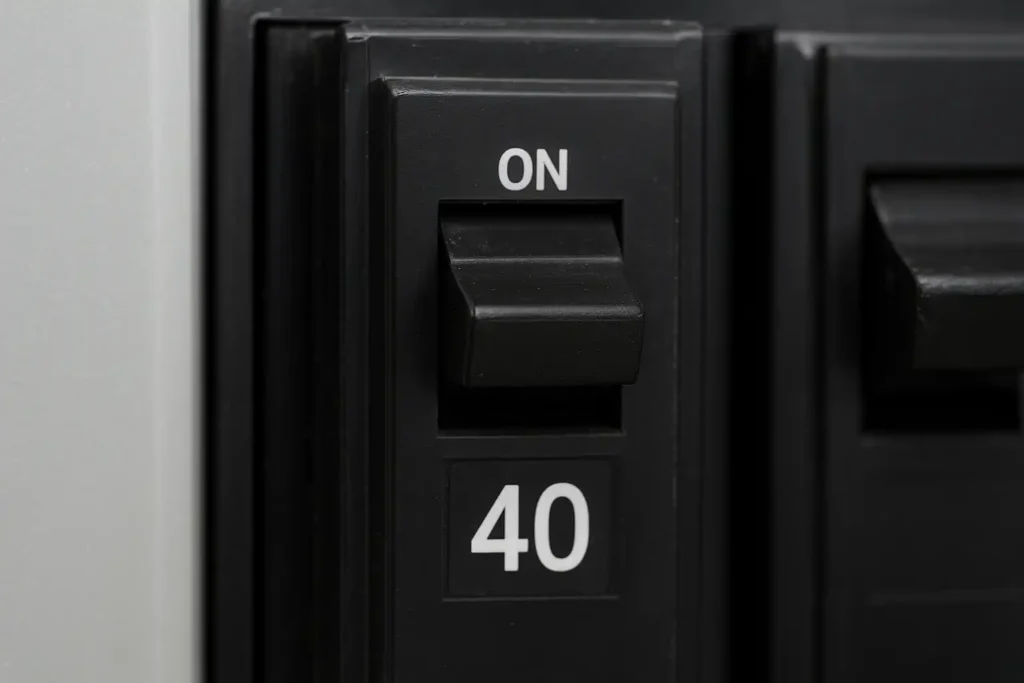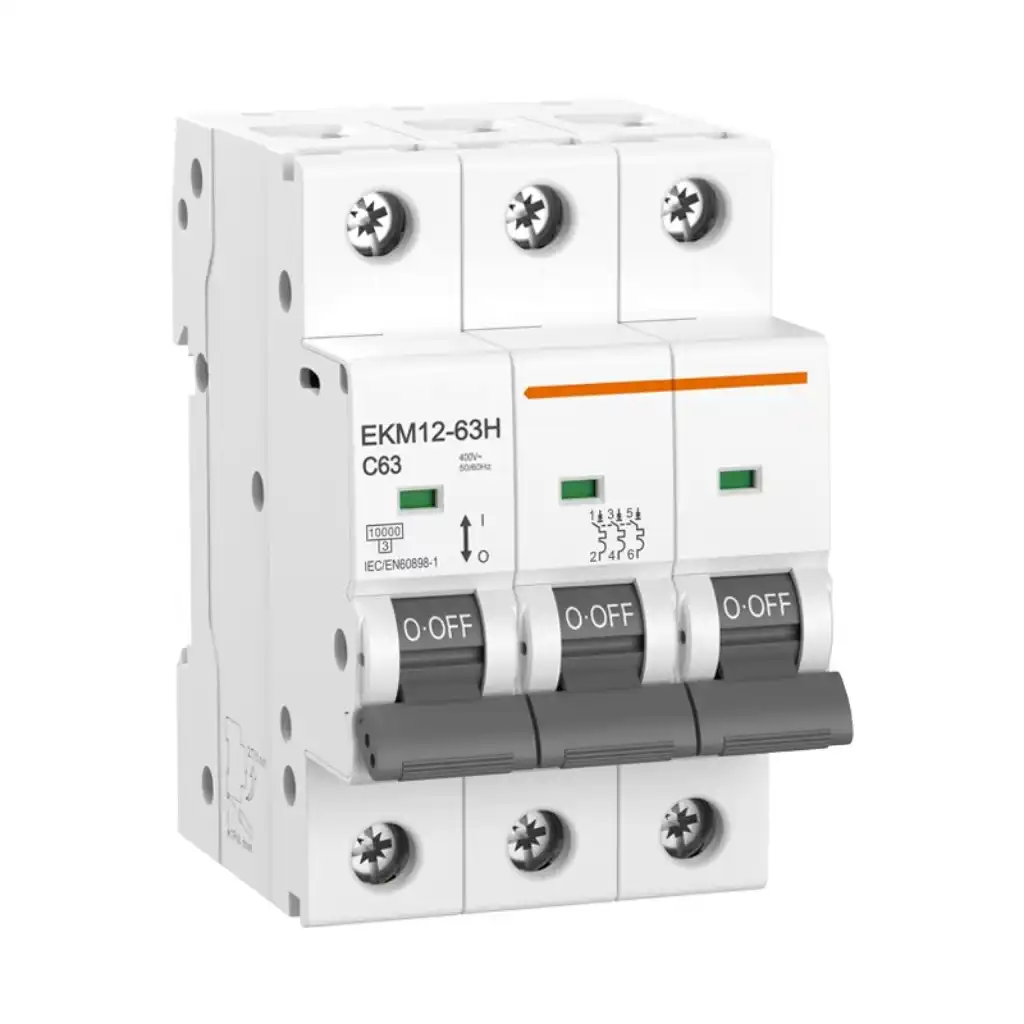For home EV chargers that use up to 32A, you need a 40A miniature circuit breaker with a Type B curve. If your charger uses 40A, you usually need a 50A breaker. The breaker should match your charger’s current to stop overloads and keep things safe. You must follow the NEC 125% rule, pick the right trip curve, and use the correct wire size. Circuit breakers can fail in EV charging setups because of:
- Ground faults, power changes, and too much heat
- Circuits that have too much load or wires that are too small
- Bad installation or stress from the environment
Choosing the right size, installing it well, and following the rules help you avoid these problems and make sure charging works every time.
Key Takeaways
- Pick a 40A Type B miniature circuit breaker for home EV chargers up to 32A. This helps keep charging safe and steady.
- Use the NEC 125% rule. Size your breaker at 125% of your charger’s current. This stops overheating and keeps the breaker from tripping too much.
- Use 8 AWG copper wire with a 40A breaker. This stops wires from getting too hot and keeps power flowing well.
- Pick manual reset breakers for EV chargers. These let you turn power back on safely after a trip. They help stop the same problem from happening again.
- Always follow local rules. Hire a licensed electrician to put in breakers and safety devices like Type B RCCBs. This gives you the right protection.
40A Miniature Circuit Breaker Basics
What It Is
A 40A miniature circuit breaker keeps your electric car charger safe from too much current or short circuits. You put this device in your electrical panel. It will shut off power if the current gets too high. This stops your charger and wires from getting damaged. The breaker has a thermal-magnetic part that senses when the current is unsafe. You can turn it back on by hand after it trips.
Most 40A miniature circuit breakers are put on a DIN rail. This makes them simple to install or change. Their small size fits well in home or business panels. You must make sure the breaker matches your circuit’s voltage and current. Most Level 2 EV chargers use 240V, so you need a breaker made for that voltage.
Tip: Pick a breaker from a trusted brand. This helps keep your system safe and working well for a long time.
When to Use a 40A Breaker
A 40A miniature circuit breaker is used for Level 2 electric car chargers. These chargers run at 240VAC and give about 7kW of power. If you have a mid-sized EV, its charger will probably use about 30A. The 40A breaker can handle this safely and lets you charge your car in 4 to 5 hours.
You might also see 40A breakers where one 240V line powers two EV chargers. Each charger can use 32A, but the system lowers the current if both are charging at once. Each charger has its own breaker for more safety. This setup is good for homes with more than one EV or for public charging spots.
You should take care of your breaker to keep it working well:
- Pick the right size breaker for your circuit so it does not trip for no reason.
- Attach the breaker tightly to the DIN rail so it does not get loose.
- Check the breaker often for loose parts, rust, or damage.
- Test the breaker by turning it off and on to make sure it works.
Doing these things helps keep your EV charging circuit safe and working right.
Breaker Curve Types
Type B vs. Type C
When picking a miniature circuit breaker for your electric car charger, you should know about Type B and Type C curves. These two types react to surges and overloads in different ways. Type B breakers trip fast when there is a small surge. Type C breakers can handle bigger surges before they trip.
Here are the main differences:
- Type B breakers trip at 3 to 5 times their rated current. You use them for things like lights and home appliances.
- Type B breakers are very sensitive. They might trip too easily if your circuit has high starting currents.
- Type C breakers trip at 5 to 10 times their rated current. You use them for things like motors or transformers.
- Type C breakers do not trip as easily from short surges. They are good for places like stores or factories.
| Feature | Type B Circuit Breaker | Type C Circuit Breaker |
|---|---|---|
| Tripping Current Range | 3 to 5 times rated current | 5 to 10 times rated current |
| Tripping Time | 0.04 to 13 seconds | 0.04 to 5 seconds |
| Typical Applications | Domestic use: lighting, resistive loads | Commercial use: small motors, transformers |
| Surge Current Tolerance | Low surge tolerance; sensitive to surges | Higher surge tolerance; handles moderate surges |
| Suitability | Not suitable for circuits with normal surges | Suitable for circuits with moderate inrush currents |
| Nuisance Tripping | More prone to nuisance tripping due to surges | Less prone to nuisance tripping |
Best Curve for EV Chargers
You need a breaker that fits your EV charger’s startup and running current. Most home EV chargers do not have big surges when they start. Type B curve breakers work well for these chargers. They protect your charger and only trip when needed.
Some brands, like Zappi, say to use a 32A Type B breaker for single-phase EV chargers at 230V or 240V. This matches the charger and keeps things safe. But many experts like Type C curve breakers for EV chargers. Type C breakers can handle the quick surge when your charger starts. This helps stop the breaker from tripping for no reason.
You should always look at your charger’s manual and local wiring rules before picking a breaker. Type B curve breakers are best for home EV chargers with small surges. Type C curve breakers are better for chargers with bigger surges or places with strict surge rules. Both types keep your system safe, but the right curve makes charging work well and safely.
Sizing and Installation

NEC 125% Rule
When you pick a circuit breaker for your electric car charger, you must follow the National Electrical Code (NEC) 125% rule. This rule means your breaker needs to handle 125% of your charger’s highest current. It helps stop overheating and keeps the breaker from tripping too much during long charging. For example, if your charger uses 32 amps, you need a 40A miniature circuit breaker. If your charger uses 40 amps, you need a 50A breaker. This extra room makes your system safer and more dependable.
Note: Always check your local building codes and talk to a licensed electrician before changing your electrical system.
Here is a simple table for common charger sizes:
| Charger Type | Charger Amperage | Required Breaker Size (Amps) | Explanation |
|---|---|---|---|
| Level 2 Home Charger | 32A | 40A | 32 × 1.25 = 40 |
| Level 2 Workplace | 40A | 50A | 40 × 1.25 = 50 |
| DC Fast Charger | ~180A | 225A | 180 × 1.25 = 225 |
Wire Size for 40A Breakers
You have to use the right wire size for safety and to follow the rules. The NEC says you need 8 AWG copper wire for a 40A circuit. Using a smaller wire can make it get too hot and might start a fire. Never use two small wires together for a 40A miniature circuit breaker. If one wire breaks, the other can get too hot and be dangerous. The right wire size also helps stop power loss and keeps charging steady.
- 8 AWG copper wire is the usual choice for 40A circuits.
- Do not use two small wires together for one breaker.
- Always make sure every part of your circuit can handle the full load.
Manual vs. Automatic Reset
You can pick between manual and automatic reset miniature circuit breakers. Manual reset breakers need you to flip the switch after they trip. This lets you check for problems before turning the power back on. Automatic reset breakers turn on by themselves after they cool down. This is easy, but if the problem is not fixed, it can trip again and again. For fixed EV charger setups, you should use manual reset breakers. They are safer and let you decide when to turn the power back on.
Safety and Compliance
Code Requirements
You have to follow special rules when you put in a circuit breaker for your EV charger. These rules keep you safe from electric dangers and help you not make expensive mistakes. The National Electrical Code (NEC) and local laws tell you what you must do for EV charging circuits. Here is what you should know:
| Requirement | Description |
|---|---|
| GFCI Breaker on NEMA 14-50 Outlets | NEC says you need a GFCI breaker for NEMA 14-50 outlets used for EV charging. This stops shock dangers from ground faults. |
| Purpose of GFCI | GFCI breakers find small changes in current and trip fast to stop shocks or damage. |
| Nuisance Tripping Issue | Many EV chargers already have GFCI inside. Adding another GFCI breaker can make it trip too much. |
| Outlet Quality | Use strong NEMA 14-50 outlets to stop overheating or fire. |
| Installation Recommendation | Always get a licensed electrician to make sure it is safe and follows the rules. |
Note: NEC Article 625 talks about EV charging systems. You also need to follow your city and state rules. Hardwired chargers with GFCI built in are safer and work better.
If you do not follow these rules, you risk more than just safety. Insurance might not pay or could cancel your policy if they find work that does not follow the rules. Bad installation can also cancel your charger’s warranty and make you pay for any damage.
RCCB/RCBO Protection
You need the right protection devices for your EV charging circuit. Type B RCCBs or RCBOs find both AC and smooth DC leakage currents. These devices keep you safe from shocks and fire that can happen while charging. Type B devices turn off power right away if they find dangerous leakage, even if it is smooth DC from your car’s battery. This kind of protection meets world safety rules and keeps your home and family safe.
If you use the wrong RCCB, like Type AC, it cannot find DC leakage. This can let faults go unnoticed and cause shocks or fire. Some EV chargers have DC detection inside, but you should always check your charger’s manual and local rules. The right RCCB/RCBO is not just a tip—it is needed for safe and legal EV charging.
You need a 40A miniature circuit breaker with a Type B curve for EV chargers that use up to 32A. If your charger uses 40A, pick a 50A breaker. The breaker size, curve, and wire thickness must match your charger. If you use the wrong breaker, it can be unsafe, trip too much, or not protect your charger:
| Consequence | Explanation |
|---|---|
| Safety Hazards | Wires can get too hot and start a fire |
| Frequent Tripping | A small breaker shuts off charging often |
| Lack of Protection | A big breaker does not stop damage |
- Ask a licensed electrician to:
- Look at your panel’s power
- Make sure you follow the rules
- Install everything safely
Good installation helps your EV charger work well and stay safe.
FAQ
What does a Type B curve breaker do for EV chargers?
A Type B curve breaker trips quickly when it detects a small surge. You use it for home EV chargers because it protects against overloads and short circuits. This breaker helps keep your charging setup safe and reliable.
What wire size should you use with a 40A breaker?
You should use 8 AWG copper wire for a 40A breaker. This wire size handles the current safely and prevents overheating. Always check that every part of your circuit matches this requirement.
What happens if you use the wrong breaker size?
If you use a breaker that is too small, it trips often and interrupts charging. If you use one that is too large, it may not protect your wires or charger. You risk fire or equipment damage.
What is the NEC 125% rule for EV chargers?
The NEC 125% rule means you must size your breaker at 125% of your charger’s rated current. This rule helps prevent overheating during long charging sessions. For example, a 32A charger needs a 40A breaker.
What safety devices should you install with your EV charger?
You should install a Type B RCCB or RCBO. These devices detect both AC and DC leakage currents. They protect you from electric shock and fire hazards during charging.
See also
Din rail 40A 240V a residual current device
How to Choose the Right MCB Size for a 22kW Electric Vehicle Charger
What Makes Type B RCD Essential for EV Chargers?
How to Choose the Right Circuit Breaker for Your Electric Vehicle Charging Setup
What Happens If Your Electric Vehicle Charger Lacks Surge Protection




